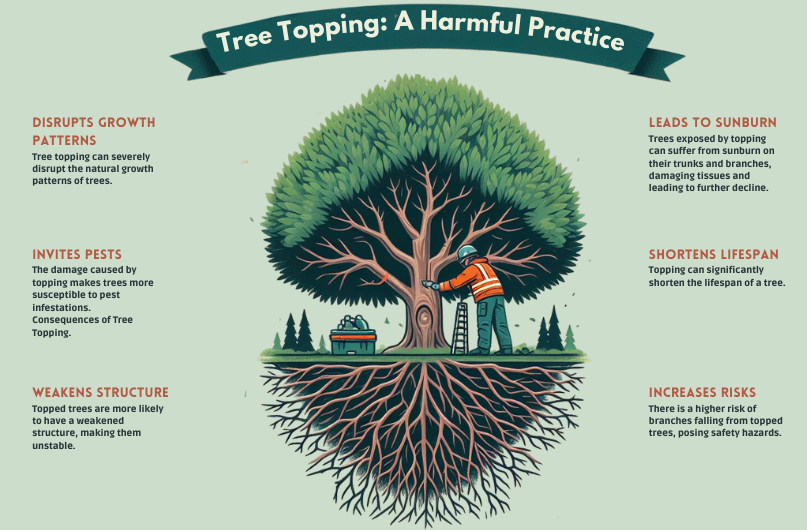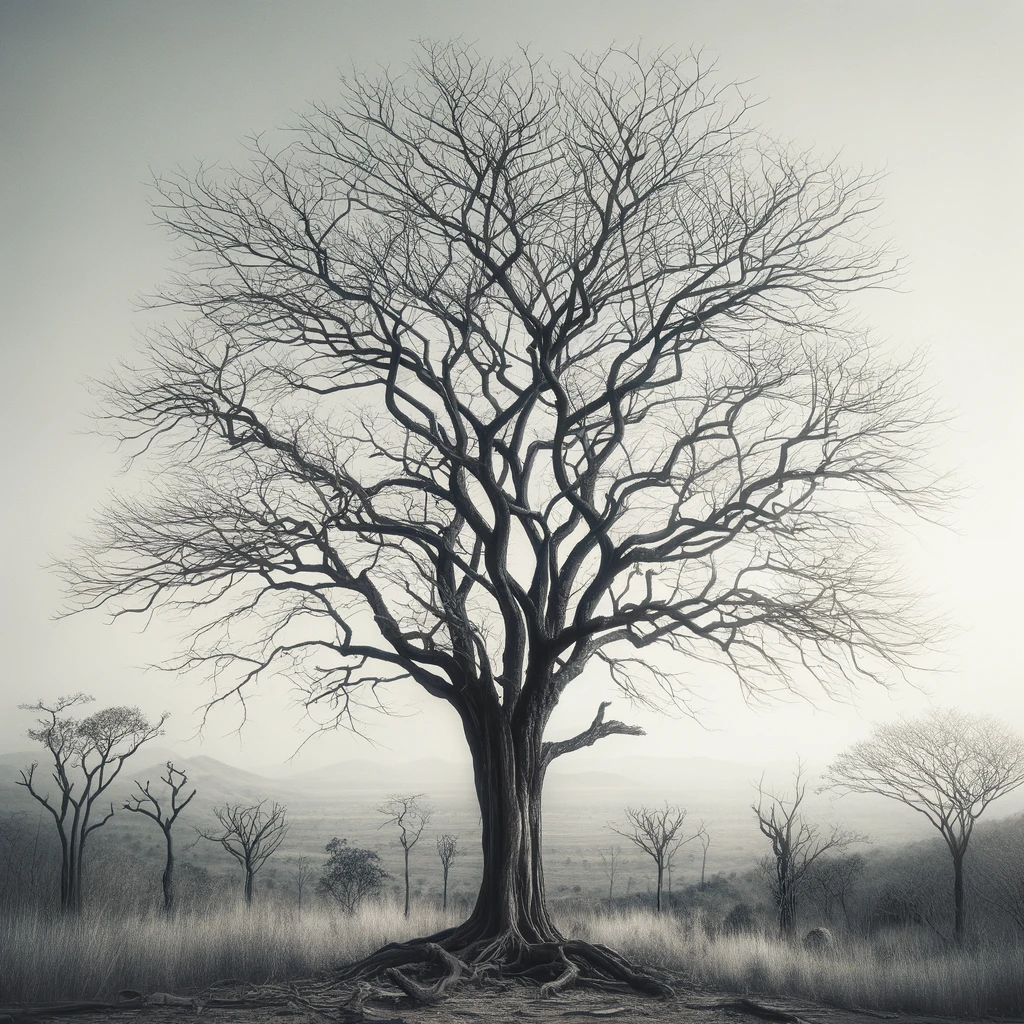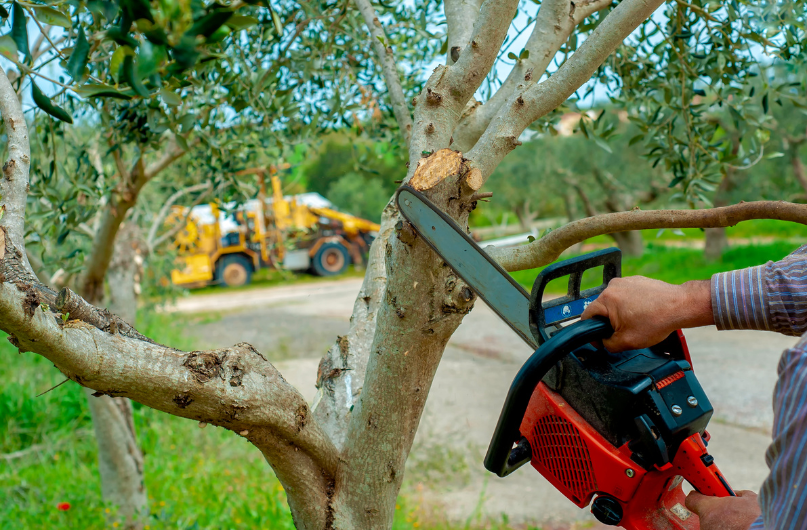Tree topping, often seen as a quick fix for managing tree height, has sparked debates among arborists and tree enthusiasts alike. The question remains - does this practice truly harm trees in the long run?
While some may argue in favor of tree topping for its immediate results, a deeper look into its effects on tree health reveals a different story. Stay tuned to uncover the intricacies surrounding tree topping and its repercussions on tree vitality and longevity.

What are the consequences of tree topping and how does it impact the overall health and longevity of trees?
Tree topping, the practice of indiscriminately cutting off numerous branches from a tree, has severe repercussions on tree health and longevity. By drastically reducing the height of the tree, topping inhibits important growth patterns, weakens the tree's structure, and creates open wounds that expose the tree to various risks.
Topped trees are at a higher risk of falling, as the natural balance and stability are compromised, leading to potential hazards for property and individuals. Additionally, the wounds left by topping make the tree vulnerable to pests, diseases, and premature death, reducing its lifespan compared to non-topped trees.
Understanding these consequences is essential in promoting the proper care and maintenance of trees to ensure their longevity and well-being. It is essential to explore alternative practices such as proper trimming, pruning, and crown reduction to maintain tree health and appearance without causing harm.

Tree topping greatly compromises the overall health and vitality of trees by disrupting their natural growth patterns and exposing them to increased risks of disease and pest infestation. When trees are topped, they lose a significant portion of their foliage, reducing their ability to photosynthesize and receive essential nutrients. This can lead to stunted growth, dieback of branches, and in severe cases, premature death of the tree.
The open wounds left from topping serve as entry points for pests and diseases, further weakening the tree's defenses. Additionally, the lack of new leaf growth after topping can result in the tree's inability to produce enough food to sustain itself, eventually leading to its demise. Trees that are repeatedly topped become increasingly vulnerable and may ultimately succumb to the stress, resulting in a shorter lifespan compared to non-topped trees.
Basically, tree topping poses a grave threat to the health and longevity of trees, making it a harmful practice that should be avoided.
Examining the detrimental effects of tree topping reveals a range of risks associated with this harmful practice. Tree topping weakens trees by hindering their ability to produce food through photosynthesis, leading to a decline in overall tree health. Additionally, the practice of topping creates large open wounds on trees, making them vulnerable to decay, pests, and diseases that can further compromise their structural integrity.
Moreover, the fast-growing sprouts that emerge after topping are poorly attached to the tree and are more likely to fail, increasing the risk of limb breakage. Over time, topping can starve trees, ultimately resulting in their death. Furthermore, the vulnerabilities caused by topping make trees more susceptible to hazards such as branch drop and structural instability, posing risks to both the tree itself and surrounding property.
Understanding these risks highlights the importance of avoiding tree topping and seeking alternative methods to promote tree health and safety.
When considering alternatives to tree topping, it is important to explore pruning techniques like thinning and crown reduction.
These methods not only help control tree size but also promote healthy tree growth.

Pruning methods such as crown reduction and selective thinning offer effective alternatives to tree topping, promoting tree health and structural integrity. Proper pruning techniques play a critical role in maintaining the health and aesthetics of trees without causing harm.
Crown reduction involves selectively removing branches to reduce the tree's overall size while encouraging healthy growth patterns. Selective thinning, on the other hand, focuses on removing specific branches to improve air circulation and light penetration within the canopy.
Consulting with a certified arborist can provide valuable guidance on the most suitable pruning techniques for individual trees. By opting for professional pruning methods over tree topping, trees can thrive, ensuring their long-term health and vitality while preserving their natural beauty.
To encourage peak tree growth while preserving tree health and structure, utilizing alternatives such as crown reduction and canopy thinning proves to be effective methods that avoid the detrimental effects of tree topping practices. Skilled arborists can carefully reduce tree size without causing harm, employing proper pruning techniques to maintain tree vitality.
By thinning the tree canopy, more light and air circulation reach the tree, enhancing its overall health and structural integrity. Employing correct tree maintenance practices like crown reduction not only fosters healthy growth but also helps prevent the necessity of resorting to harmful tree topping methods.
Seeking guidance from professionals such as Brockley Tree Services can secure that trees thrive without the need for detrimental tree topping practices.
Engaging a certified arborist provides essential expertise for implementing best tree care practices. These professionals offer valuable guidance to guarantee the health and longevity of your trees. Here are four key reasons why seeking professional advice on tree care is vital:
When considering tree care, the focus should be on preserving tree health and longevity. Consulting with certified arborists for expert guidance can lead to better outcomes.
Understanding the impact of topping and exploring alternatives like thinning and crown reduction techniques is vital for maintaining tree structure and aesthetics.
Considering tree health is paramount when making decisions about tree care to guarantee the long-term well-being and safety of the tree.
To guarantee the health and vitality of trees, it is essential to:
Opting for expert crown reduction or canopy thinning instead of topping can help maintain tree health and safety in the long run.
To make informed decisions for tree health, understanding the detrimental impact of tree topping on tree vitality and long-term well-being is important. Tree topping greatly reduces a tree's ability to produce food through photosynthesis, leading to stunted growth and weakened overall health.
Additionally, topped trees are prone to limb failure as the regrown branches are weaker and more susceptible to breakage. The practice of topping also creates openings for pests, diseases, and decay to infiltrate the tree, heightening its vulnerability to further damage.
Over time, topped trees can suffer from malnourishment and eventually die due to the cumulative effects of topping. In addition, topping increases the risk of decay and impedes the tree's capacity to heal wounds properly, posing ongoing hazards to its structural integrity.
When it comes to maintaining the health and beauty of your trees, it's essential to entrust the job to professionals who have the expertise and dedication to deliver exceptional results. At our Tree Care Services, we offer a comprehensive range of tailored solutions to meet all your tree care requirements. Here's why you should choose us for your tree care needs:
For the best care possible for your trees, it's crucial to seek the advice of a professional arborist. Arborists are trained experts who understand the unique needs of each tree species. Consulting with an arborist ensures that your trees receive the care they need to thrive and remain beautiful for years to come.
Our team of skilled arborists at Landscaping HQ is dedicated to upholding the highest standards in tree care services. With years of experience and a commitment to delivering exceptional results, our arborists provide reliable solutions for both residential and commercial properties.
Whether you require tree trimming, removal, stump grinding, arborist consulting, or land clearing services, our experienced team is here to help. We specialize in strategic planting of new trees for replacement or safety reasons, ensuring the long-term health and beauty of your landscaping.
From annual tree trimming to emergency tree removal services, we offer trustworthy and dependable solutions to meet all your tree care needs. Our holistic approach to tree care focuses on enhancing the overall appearance and health of your trees, promoting enduring vitality and beauty.
When you choose our Tree Care Services, you can rest assured that your trees are in good hands. Trust our expertise and dedicated team to provide the professional care your trees deserve. Contact us today to schedule a consultation and experience the difference that professional arborist services can make for your property.
Tree topping is not recommended as it harms trees by weakening their structure and making them more susceptible to environmental stressors. Expert arborists advise against this practice and recommend alternatives like crown reduction for tree health and safety.
Topping a tree drastically reduces its canopy, hampers photosynthesis, creates wounds inviting pests and disease, promotes weak branch growth prone to breakage, and leads to tree starvation. This harmful practice should be avoided to guarantee tree health and longevity.
Cutting the top off a tree, known as topping, greatly harms the tree by impeding photosynthesis, creating vulnerabilities to pests and diseases, promoting weak branch growth, reducing food sources, and compromising the tree's health and longevity.
Alternative techniques to tree topping include thinning and crown reduction by skilled arborists. These methods improve tree health by reducing wind resistance, enhancing structural integrity, allowing better light penetration, and promoting air circulation. Consulting professionals like Brockley Tree Services can offer sustainable solutions.
To sum up, tree topping is a harmful practice that negatively impacts tree health and longevity. By creating open wounds and inhibiting healthy growth, topped trees are more susceptible to falling and have shorter lifespans.
It is important to explore alternative methods such as proper trimming, pruning, and consulting arborists to maintain tree health effectively. Making informed decisions and avoiding tree topping will contribute to the well-being and safety of trees in the long run.